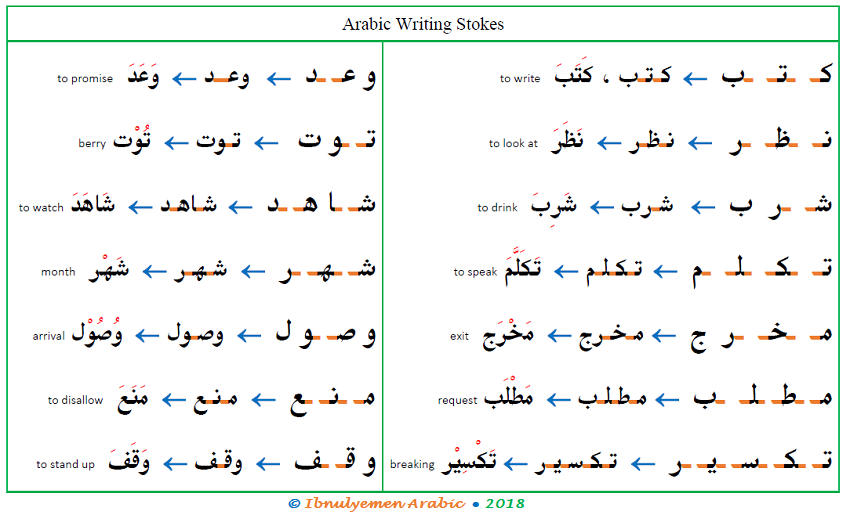In the previous lesson, you learned why a word in Arabic that constitutes the same letters can have multiple different meanings and pronunciations. The word سلم is composed of س, then ل, and finally م. Their shape in isolation is slightly different from their shape in a word. In this lesson, we will learn how to join Arabic letters to form words.
 Unlike Romance languages, such as English and French, Arabic is a right-to-left language. That is to say, we write it from right to left. In the table above, you can see that the writing strokes go from right to left. For example, if we take the first word on the right, you can see that there is a horizontal line between ك and ت and ب to make them connect easily. When we add this line before or after the letter, the letter shape changes to suit this horizontal line.
Unlike Romance languages, such as English and French, Arabic is a right-to-left language. That is to say, we write it from right to left. In the table above, you can see that the writing strokes go from right to left. For example, if we take the first word on the right, you can see that there is a horizontal line between ك and ت and ب to make them connect easily. When we add this line before or after the letter, the letter shape changes to suit this horizontal line.
When we add a line (ــ) after ك, its shape changes to كـ. Similarly, when we add ت after this line, its shape changes to ـت. Furthermore, as we add another line after it so that it can easily join with the subsequent letter, its shape changes to ـتـ. Finally, the shape of the last letter changes to ـب to easily join to the line that follows the preceding ت, hence كتب is created. Therefore, it is the horizontal line before and after the letters that causes the changes in letter shapes. It makes them join easily to form words, such as كَتَبَ 'he wrote', نَظَرَ 'he looked at' and so forth.
Looking at the right-to-left stroke drawing in the table above, you can see that before and/or after each letter in black there is a short dash-like connecting line in orange. These short lines are clearly visible in the decomposed words. These short lines merge into a single line to successively connect the letters together to form whole words. In handwriting, we first connect the letters. Then we add dots above or below the letters. Finally, we add the diacritical marks.
To reiterate, as you put pen to paper with the first letter, remember that it (except the semi-joining ones) will be followed by a short joining line, so its shape must change in order to join properly with this line. This short line will, in turn, join with another letter so this letter must change shape to easily join with the preceding letter. To join this second letter with another after it, we must add a short line after it. This line will further change the shape of this letter and cause the shape of the third letter to change. We repeat this process until we fully write a whole word. Once we write the word completely, we add the dots above or below the letters. Then, we assign the diacritics. Et voila, you are now able to write a word easily. Remember, practice makes perfect.